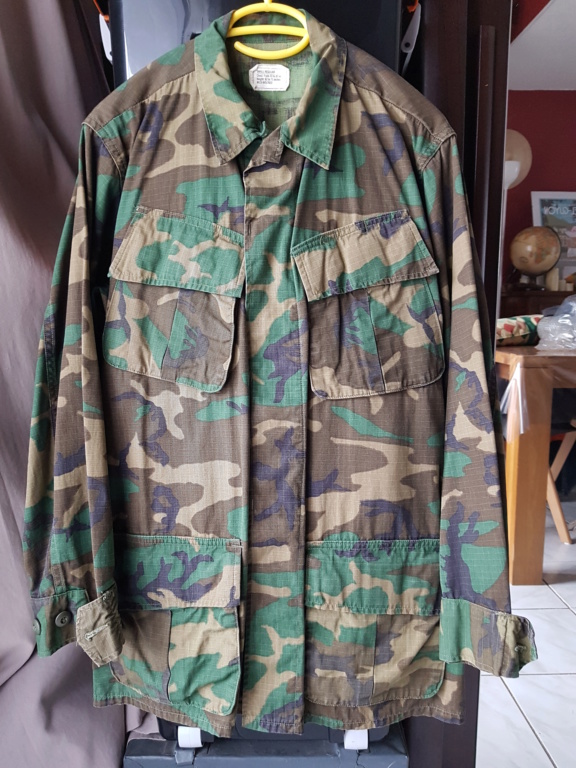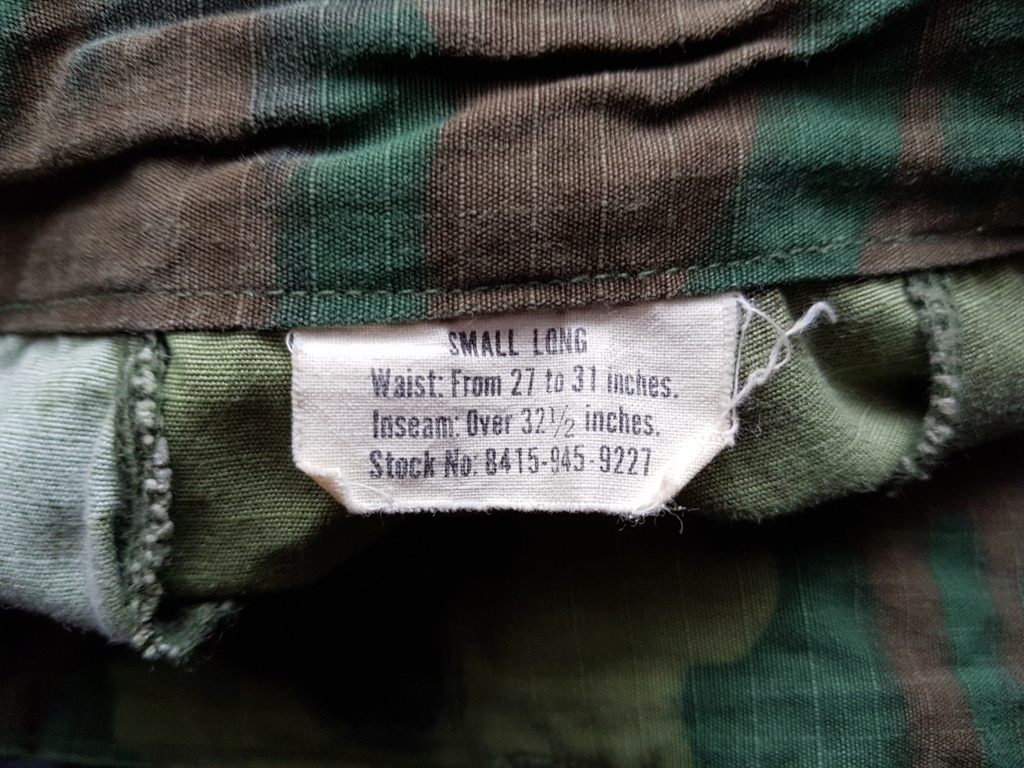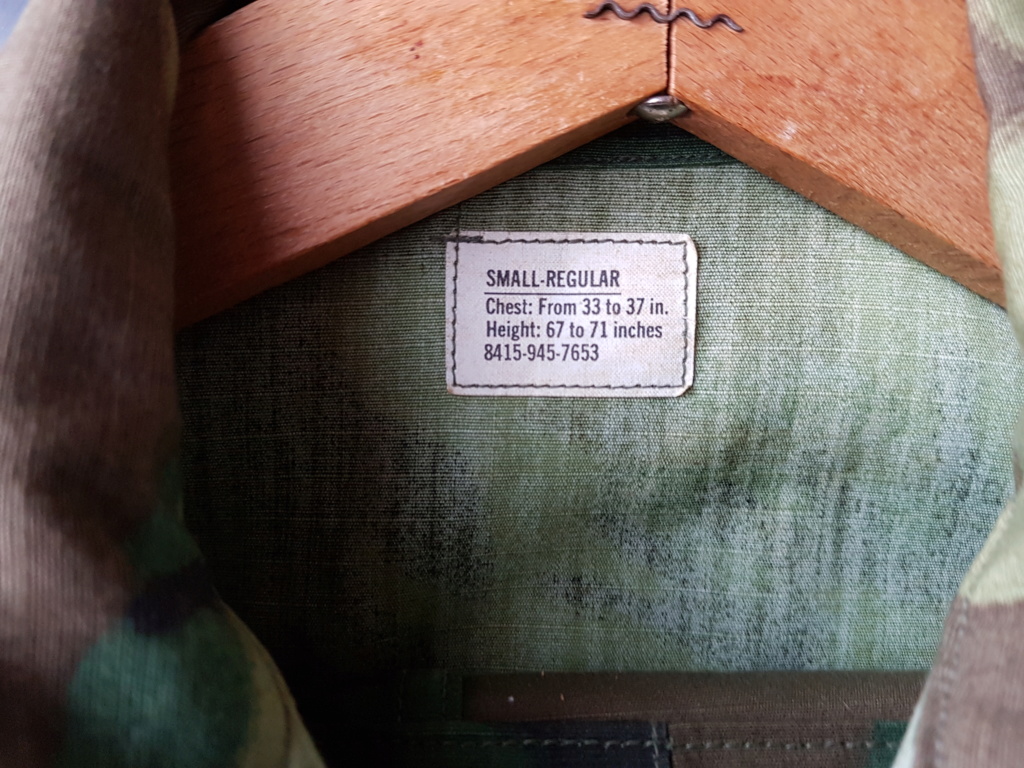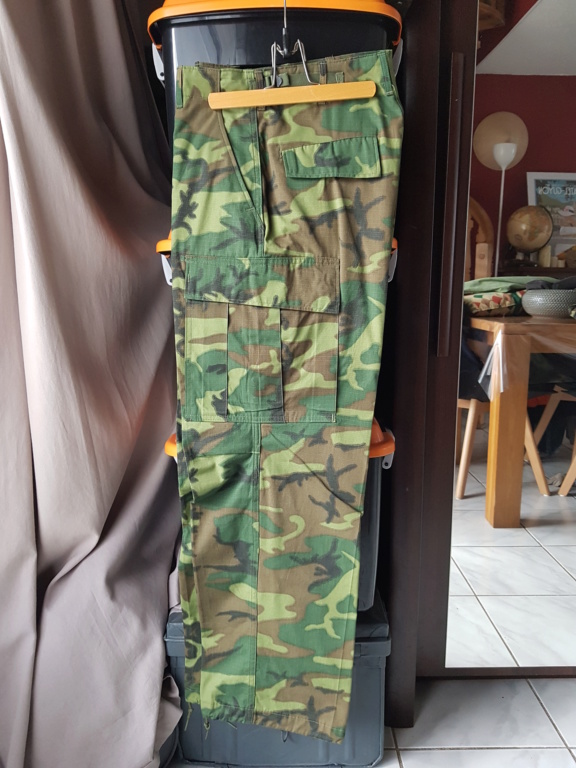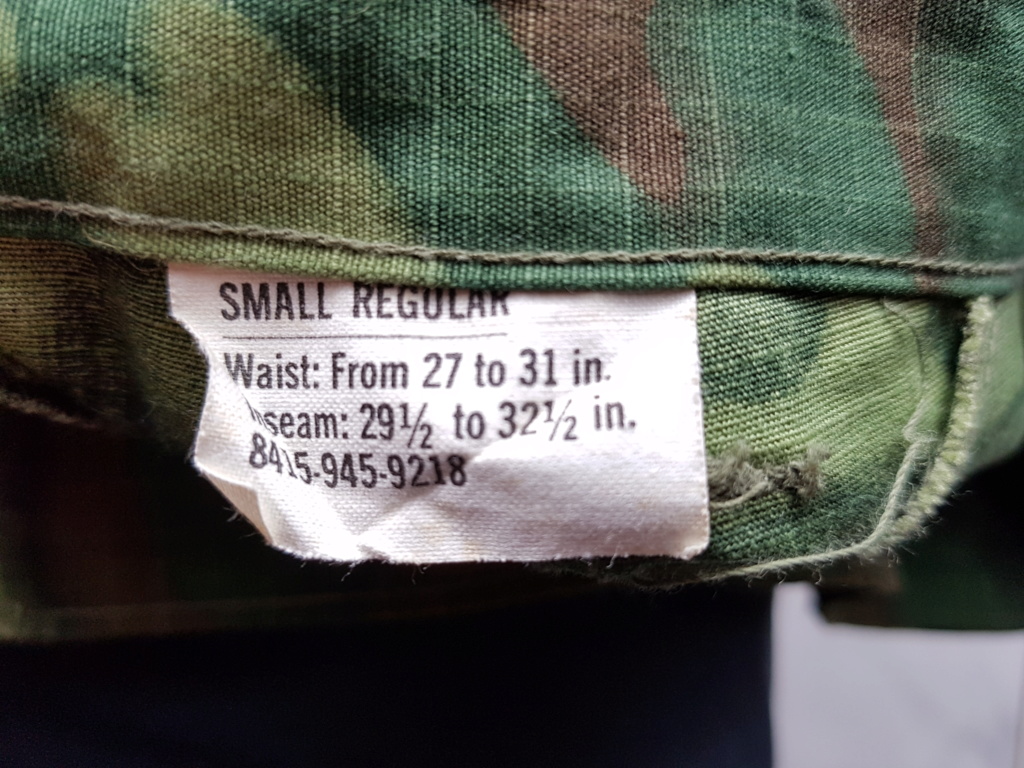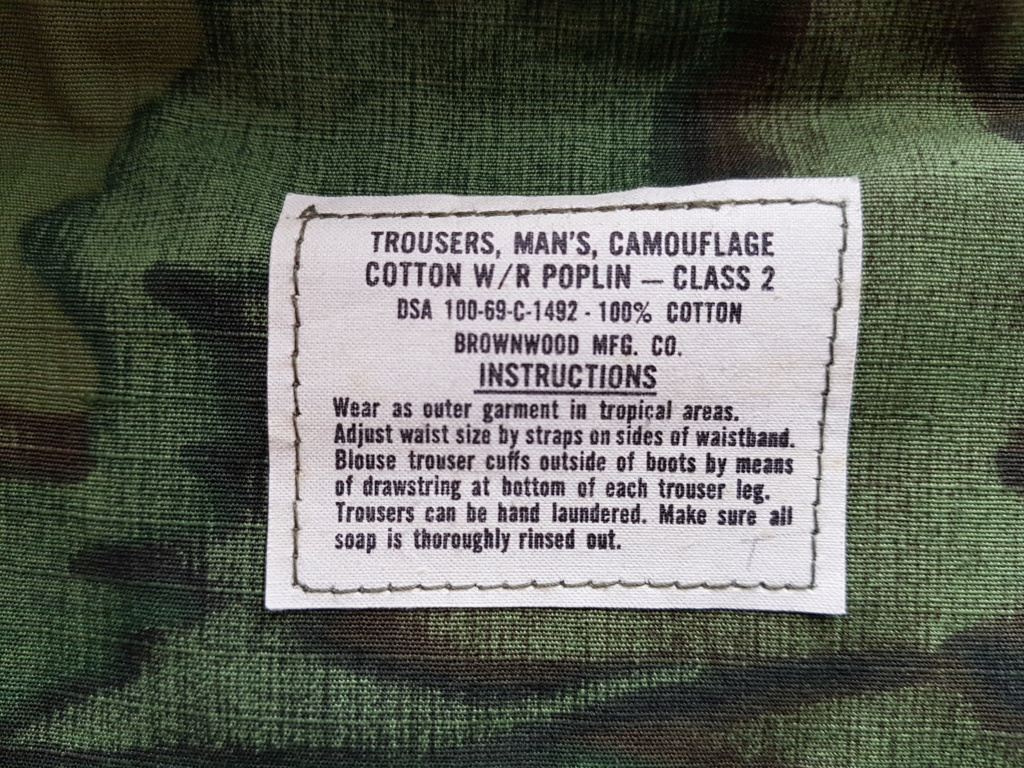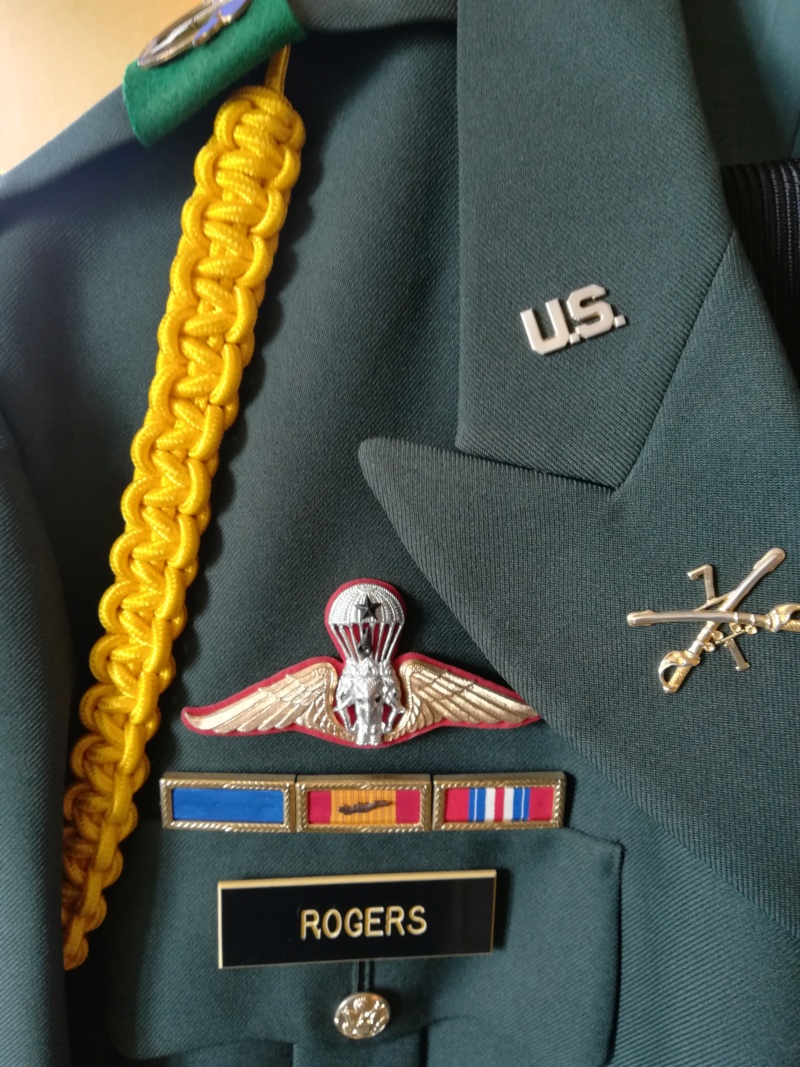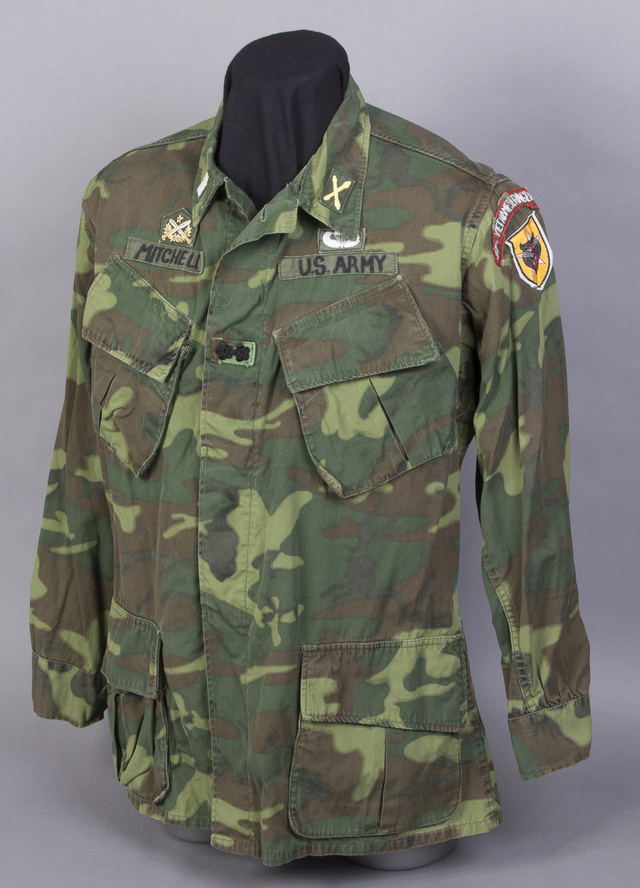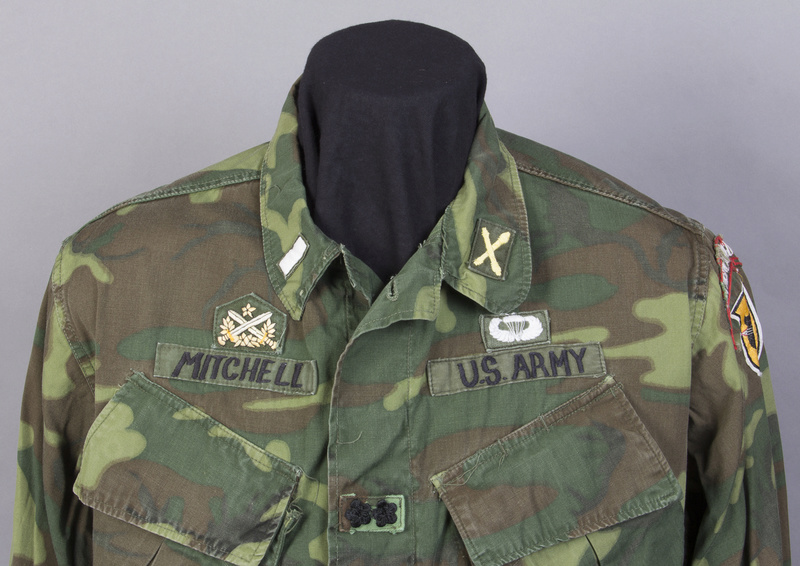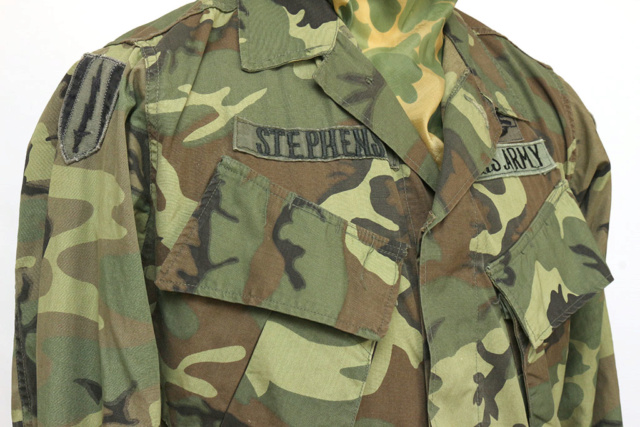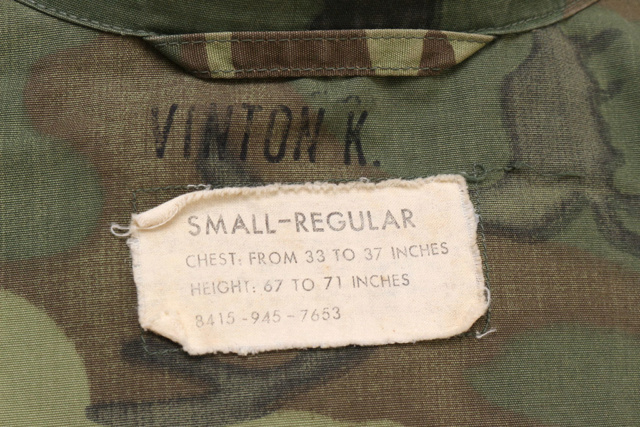Vos uniformes ERDL
+9
wolfen
Puff
Rob1
fumaco
fafane83
jeune chien fou
Sneeden
HUSTIN
toitoine66
13 participants
Vietnamwar :: CONFLIT VIETNAMIEN :: L'armée américaine et ses alliés :: Uniformologie :: Tenues camouflées américaines
Page 2 sur 3
Page 2 sur 3 •  1, 2, 3
1, 2, 3 
 Re: Vos uniformes ERDL
Re: Vos uniformes ERDL
@tiotoine:
le boonie hat est fort sympatique aussi
@fafane:
je suis impressionné par tous ces ERDL poplin.
Il faut chercher dans les combiens, ces temps-ci ?
(je sais: quand on en trouve....)
le boonie hat est fort sympatique aussi
@fafane:
je suis impressionné par tous ces ERDL poplin.
Il faut chercher dans les combiens, ces temps-ci ?
(je sais: quand on en trouve....)

Sneeden- Messages : 921
Date d'inscription : 06/06/2018
Age : 51
Localisation : Franche-Comté
 Re: Vos uniformes ERDL
Re: Vos uniformes ERDL
Sneeden a écrit:@tiotoine:
le boonie hat est fort sympatique aussi
@fafane:
je suis impressionné par tous ces ERDL poplin.
Il faut chercher dans les combiens, ces temps-ci ?
(je sais: quand on en trouve....)
@toitoine
Je m'interroge sur ce boonie hat brown dominant. Est-il d'époque ou post nam?
@sneeden
Difficile à dire. Cela dépend de l'état général, sachant que le plus dure à trouver sont les pantalons...
Le 1er ensemble no rip stop que j'ai présenté (contrats 7384 et 7385), dans cet état de conservation, m'est revenu à environ 600$... c'est, je pense, le ERDL 3rd pattern le plus quoté...
fafane83- Messages : 324
Date d'inscription : 02/09/2014
Age : 47
Localisation : SAINT-RAPHAEL (83)
 Re: Vos uniformes ERDL
Re: Vos uniformes ERDL
Le bonnie Hat est une repro de chez SOF les gars ahah ! Il sera bientôt a vendre sur mon Surplus vu que je vais recevoir le bonnie ERDL de Wolf pour compléter comme il se doit ma tenue ERDL mint 
Pour l’étiquette je vais pas chipoter au prix ou je l'ai sortie celle la ....
Pour l’étiquette je vais pas chipoter au prix ou je l'ai sortie celle la ....
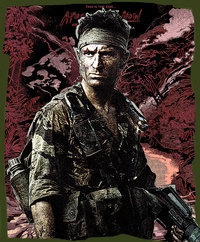
toitoine66- Messages : 1217
Date d'inscription : 18/03/2014
Age : 33
Localisation : Diên Biên Phu: Hugette 7
 Re: Vos uniformes ERDL
Re: Vos uniformes ERDL
Merci pour toutes ces précisions.
Le boonie Brown Dominant a t'il été vu pendant le conflit ?

Q:fafane83 a écrit:Je m'interroge sur ce boonie hat brown dominant. Est-il d'époque ou post nam?
Le boonie Brown Dominant a t'il été vu pendant le conflit ?

Sneeden- Messages : 921
Date d'inscription : 06/06/2018
Age : 51
Localisation : Franche-Comté
 Re: Vos uniformes ERDL
Re: Vos uniformes ERDL
Q:fafane83 a écrit:Je m'interroge sur ce boonie hat brown dominant. Est-il d'époque ou post nam?
Le boonie Brown Dominant a t'il été vu pendant le conflit ?
Pas à ma connaissance. Où alors des "in country made" peut être? C'est bien pour ça que je posais la question
fafane83- Messages : 324
Date d'inscription : 02/09/2014
Age : 47
Localisation : SAINT-RAPHAEL (83)
fafane83- Messages : 324
Date d'inscription : 02/09/2014
Age : 47
Localisation : SAINT-RAPHAEL (83)
LT John Rinney aime ce message
fafane83- Messages : 324
Date d'inscription : 02/09/2014
Age : 47
Localisation : SAINT-RAPHAEL (83)
LT John Rinney aime ce message
fafane83- Messages : 324
Date d'inscription : 02/09/2014
Age : 47
Localisation : SAINT-RAPHAEL (83)
 Re: Vos uniformes ERDL
Re: Vos uniformes ERDL

La veste USMC, rolàlà
Vraiment superbe ....

Sneeden- Messages : 921
Date d'inscription : 06/06/2018
Age : 51
Localisation : Franche-Comté
 une veste ERDL USAF CCT
une veste ERDL USAF CCT
salut,
une trouvaille d'hier:
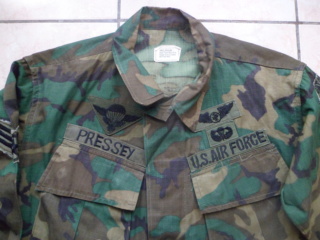
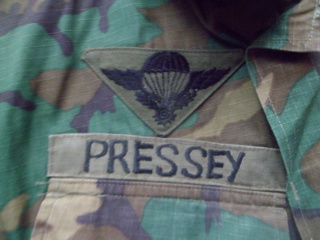
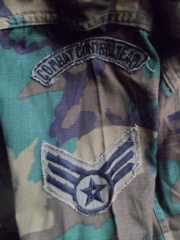
Vietnam War[edit]
See also: Forward air controllers in the Vietnam War and Laotian Civil War
In the Vietnam War, Combat Controllers helped assure mission safety and expedited air traffic flow during countless airlifts. Combat Controllers also flew as forward air guides in support of indigenous forces in Laos and Cambodia. Combat Controllers conducted covert forward air control for U.S. and allied aircraft performing interdiction missions against Communist troops and supplies on the Ho Chi Minh trail.The first combat controller killed in action in SE Asia was TSgt Richard L. Foxx, a seasoned combat controller with more than 15 years experience. On 15 October 1962, Sergeant Foxx was killed while performing Forward Air Control (FAC) duties in a U-10 Helio Courier [22]
As tactical air strikes began to be used in Laos, it became apparent that for the safety of noncombatants, some means of control was necessary.[23] Beginning at least as early as July 1964, the absence of a close air support control system caused a variety of enterprising individuals to improvise procedures for marking bombing targets. At various times, ground markers (including bamboo arrows) and dropped smoke grenades were used. While some of these individuals had military training, such as the American Army Attaché, others had little or no specialized training in close air support. They varied in nationality, being Thai, Lao, or Hmong, as well as American.[24] Both Continental Air Services, Inc and Air America pilots would sometimes serve as ad hoc forward air controllers.[25]
Butterflies[edit]
To begin an operation of great secrecy, the U. S. Air Force originally forwarded four sergeants from Combat Control Teams in 1963. These sergeants turned in their uniforms and military identification and were supplied with false identification so they could work in civilian clothing. This process was designed to preserve the fiction of American non-involvement dubbed plausible deniability. Once "civilianized", the Butterflies flew in the right (co-pilot's) seat in Air America Helio Couriers and Pilatus Porters. They were often accompanied by a Lao or Thai interpreter in the back seat. The Air Commando sergeants directed the air strikes according to U. S. Air Force doctrine, using the radio call sign Butterfly.[26]
Two of the Butterfly Air Force combat controllers were Master Sergeant Charles Larimore Jones, soon joined by Technical Sergeant James J. Stanford.[27] Another of the Butterflies was Major John J. Garrity, Jr., who in future would spend several years as the éminence grise of the American Embassy to Laos.[28] They, and their successors, ran air strikes without notice or objection until General William Momyer discovered that enlisted men were in charge of air strikes; at that point, he ordered their replacement with rated fighter pilots. By that time, the number of Butterflies had escalated to three pairs.[29] Both the impromptu strike controlling and the Butterfly effort ended with General Momyer's tirade in April 1966.[30]
Development of rules of engagement by the Embassy also threw more reliance on increased control over the in-country close air support. So did the introduction of an integrated close air support system for Southeast Asia in April 1966.[31] Also, beginning in April 1966, part of its effort to better direct air strikes, the U. S. Air Force installed four tactical air navigation systems in Laos to guide U. S. air strikes. One of these was emplaced on a mountain top at Lima Site 85, aimed across the border at Hanoi.[32]
There were four Combat Controllers killed in action in Vietnam members of 8th Aerial Port Squadron Combat Control Team 3, Element C. Msgt Charles A.Paradise, TSgt Frederick L. Thrower, Airman 1st Class Gerard Louis Gauthier Jr, Airman 1st Class, William E Jerkins.[33]
A1C ANDRE R. GUILLET, 1966,as a "Butterfly" forward air controller MIA – Laos[34]
voila voila.. assez content!!
par contre je ne trouve pas d'infos sur cet homme.. si jamais!
merci
une trouvaille d'hier:



Vietnam War[edit]
See also: Forward air controllers in the Vietnam War and Laotian Civil War
In the Vietnam War, Combat Controllers helped assure mission safety and expedited air traffic flow during countless airlifts. Combat Controllers also flew as forward air guides in support of indigenous forces in Laos and Cambodia. Combat Controllers conducted covert forward air control for U.S. and allied aircraft performing interdiction missions against Communist troops and supplies on the Ho Chi Minh trail.The first combat controller killed in action in SE Asia was TSgt Richard L. Foxx, a seasoned combat controller with more than 15 years experience. On 15 October 1962, Sergeant Foxx was killed while performing Forward Air Control (FAC) duties in a U-10 Helio Courier [22]
As tactical air strikes began to be used in Laos, it became apparent that for the safety of noncombatants, some means of control was necessary.[23] Beginning at least as early as July 1964, the absence of a close air support control system caused a variety of enterprising individuals to improvise procedures for marking bombing targets. At various times, ground markers (including bamboo arrows) and dropped smoke grenades were used. While some of these individuals had military training, such as the American Army Attaché, others had little or no specialized training in close air support. They varied in nationality, being Thai, Lao, or Hmong, as well as American.[24] Both Continental Air Services, Inc and Air America pilots would sometimes serve as ad hoc forward air controllers.[25]
Butterflies[edit]
To begin an operation of great secrecy, the U. S. Air Force originally forwarded four sergeants from Combat Control Teams in 1963. These sergeants turned in their uniforms and military identification and were supplied with false identification so they could work in civilian clothing. This process was designed to preserve the fiction of American non-involvement dubbed plausible deniability. Once "civilianized", the Butterflies flew in the right (co-pilot's) seat in Air America Helio Couriers and Pilatus Porters. They were often accompanied by a Lao or Thai interpreter in the back seat. The Air Commando sergeants directed the air strikes according to U. S. Air Force doctrine, using the radio call sign Butterfly.[26]
Two of the Butterfly Air Force combat controllers were Master Sergeant Charles Larimore Jones, soon joined by Technical Sergeant James J. Stanford.[27] Another of the Butterflies was Major John J. Garrity, Jr., who in future would spend several years as the éminence grise of the American Embassy to Laos.[28] They, and their successors, ran air strikes without notice or objection until General William Momyer discovered that enlisted men were in charge of air strikes; at that point, he ordered their replacement with rated fighter pilots. By that time, the number of Butterflies had escalated to three pairs.[29] Both the impromptu strike controlling and the Butterfly effort ended with General Momyer's tirade in April 1966.[30]
Development of rules of engagement by the Embassy also threw more reliance on increased control over the in-country close air support. So did the introduction of an integrated close air support system for Southeast Asia in April 1966.[31] Also, beginning in April 1966, part of its effort to better direct air strikes, the U. S. Air Force installed four tactical air navigation systems in Laos to guide U. S. air strikes. One of these was emplaced on a mountain top at Lima Site 85, aimed across the border at Hanoi.[32]
There were four Combat Controllers killed in action in Vietnam members of 8th Aerial Port Squadron Combat Control Team 3, Element C. Msgt Charles A.Paradise, TSgt Frederick L. Thrower, Airman 1st Class Gerard Louis Gauthier Jr, Airman 1st Class, William E Jerkins.[33]
A1C ANDRE R. GUILLET, 1966,as a "Butterfly" forward air controller MIA – Laos[34]
voila voila.. assez content!!
par contre je ne trouve pas d'infos sur cet homme.. si jamais!
merci
fumaco- Messages : 95
Date d'inscription : 19/06/2017
LT John Rinney aime ce message
 Re: Vos uniformes ERDL
Re: Vos uniformes ERDL
hello fumaco trés jolie veste mais on a un topic special ERDL a remplir 
https://vietnamwar.forumactif.org/t2607-vos-tenues-erdl
C'est fusionné
https://vietnamwar.forumactif.org/t2607-vos-tenues-erdl
C'est fusionné

toitoine66- Messages : 1217
Date d'inscription : 18/03/2014
Age : 33
Localisation : Diên Biên Phu: Hugette 7
 Re: Vos uniformes ERDL
Re: Vos uniformes ERDL
fumaco a écrit:par contre je ne trouve pas d'infos sur cet homme.. si jamais!
Peut-être le même ?
With the ceasefire agreements in effect—in reality only on the US side—in both Vietnam and Laos, the priority for military operations shifted to Cambodia. Detachment 1, 56 SOW, had already begun training Khmer Republic air force (Cambodian government) T-28 pilots in Thailand. Within a few months, the detachment’s combat controllers dispersed around Thailand and Cambodia. The number of special operations combat controllers assigned to Thailand at any given time never exceeded about 10 enlisted men, including, in about 1973, Mike Brown, Mitch Bryan, Rex Evitts, Clyde Howard, John K-ren, Mike Lampe, and Stu Pressey. Several relocated to Ubon AB, near the border with Cambodia, to support operations in that country. Two or three deployed into Cambodia; two others moved to NKP to support US joint efforts to locate and repatriate Americans who had died in Southeast Asia. CCT personnel also conducted a survival school for Khmer Republic pilots and aircrew members, supported by special operations CH-53 Super Jolly Green Giant helicopters. In December 1973, Detachment 1 inactivated at Udorn, and its personnel transferred to the US Military Assistance Command, Thailand, the US training and logistics detachment for that country. But the CCT personnel stayed at Udorn through May 1975.
Trouvé dans cette histoire des Special Tactics de l'US Air Force (que je n'ai pas lue) : https://www.airuniversity.af.edu/Portals/10/AUPress/Books/B_0149_MARION_BROTHERS_IN_BERETS.PDF

Rob1- Messages : 76
Date d'inscription : 19/10/2018
 Re: Vos uniformes ERDL
Re: Vos uniformes ERDL
Elle est très très belle cette veste ! A priori, le parachute badge est Thaïlandais, mais je ne suis pas le plus grand spécialiste. En tout cas, ça collerait avec ce qu'a trouvé Rob1. Tu l'as montré à Olivier ?

Puff- Messages : 2402
Date d'inscription : 13/05/2012
 Re: Vos uniformes ERDL
Re: Vos uniformes ERDL
merci pour la fusion!
le brevet para est laotien..comme le français mais avec un truc à la place de l'étoile.
j'ai vu le gars sur photos:
http://www.sgtmacsbar.com/CCTPhotos/Gallery03/Stu/index.htm
merci pour le lien pour le bouquin..tres sympa.
le vétéran est encore en vie, je lui ai envoyé un mail..
Sinon pour répondre aux questions, j'ai plusieurs piéces en ERDL marron, pour moi les plus belles et grosso modo j'ai vu en 25 ans… 1 piéce marron pour 10 en verte.. à mon avis un poil plus rare mais bien porté au Nam.. qu'en disent le 3éme age du site? puff olivier?
le brevet para est laotien..comme le français mais avec un truc à la place de l'étoile.
j'ai vu le gars sur photos:
http://www.sgtmacsbar.com/CCTPhotos/Gallery03/Stu/index.htm
merci pour le lien pour le bouquin..tres sympa.
le vétéran est encore en vie, je lui ai envoyé un mail..
Sinon pour répondre aux questions, j'ai plusieurs piéces en ERDL marron, pour moi les plus belles et grosso modo j'ai vu en 25 ans… 1 piéce marron pour 10 en verte.. à mon avis un poil plus rare mais bien porté au Nam.. qu'en disent le 3éme age du site? puff olivier?
fumaco- Messages : 95
Date d'inscription : 19/06/2017
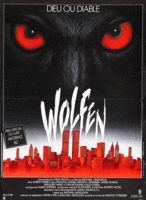
wolfen- Messages : 147
Date d'inscription : 23/01/2013
Age : 66
Localisation : Belgique
 Re: Vos uniformes ERDL
Re: Vos uniformes ERDL
Pour les ERDL brown , à ma connaissance porté par les SEAL , les USMC , et la 9 eme Division d'infanterie .

wolfen- Messages : 147
Date d'inscription : 23/01/2013
Age : 66
Localisation : Belgique
 Re: Vos uniformes ERDL
Re: Vos uniformes ERDL
C'est juste magnifique...fumaco a écrit:salut,
une trouvaille d'hier:
https://i.servimg.com/u/f89/19/79/97/31/sam_1110.jpg

Sneeden- Messages : 921
Date d'inscription : 06/06/2018
Age : 51
Localisation : Franche-Comté
 Re: Vos uniformes ERDL
Re: Vos uniformes ERDL
fumaco a écrit:le brevet para est laotien..comme le français mais avec un truc à la place de l'étoile.
Sinon pour répondre aux questions, j'ai plusieurs piéces en ERDL marron, pour moi les plus belles et grosso modo j'ai vu en 25 ans… 1 piéce marron pour 10 en verte.. à mon avis un poil plus rare mais bien porté au Nam.. qu'en disent le 3éme age du site? puff olivier?
Super pour le brevet !

Puff- Messages : 2402
Date d'inscription : 13/05/2012
 Re: Vos uniformes ERDL
Re: Vos uniformes ERDL
merci puff!
je sortirais les ERDL fond marrons.. ça fera les poussières!
je sortirais les ERDL fond marrons.. ça fera les poussières!
fumaco- Messages : 95
Date d'inscription : 19/06/2017
Beezman- Messages : 81
Date d'inscription : 20/06/2020
LT John Rinney, Puff, jeune chien fou, toitoine66, papouner, fafane83 et HUSTIN aiment ce message
 Re: Vos uniformes ERDL
Re: Vos uniformes ERDL
Splendide ! Une piece de rêve !

Puff- Messages : 2402
Date d'inscription : 13/05/2012
 Re: Vos uniformes ERDL
Re: Vos uniformes ERDL
mais comment faites-vous pour choper du poplin comme ça !?Beezman a écrit:une ERDL popeline d'un conseiller aux Rangers.
Y en a plein partout le topic !
Magnifique, bravo.

Sneeden- Messages : 921
Date d'inscription : 06/06/2018
Age : 51
Localisation : Franche-Comté

Puff- Messages : 2402
Date d'inscription : 13/05/2012
LT John Rinney, papouner et fafane83 aiment ce message
 Re: Vos uniformes ERDL
Re: Vos uniformes ERDL
pwaaaa !

OK d'accord ....
Bin magnifique, quoi.

OK d'accord ....
Bin magnifique, quoi.

Sneeden- Messages : 921
Date d'inscription : 06/06/2018
Age : 51
Localisation : Franche-Comté
 Re: Vos uniformes ERDL
Re: Vos uniformes ERDL
Sympa! Sur ta première veste le combat patch est pour la 1st Signal Brigade.
Beezman- Messages : 81
Date d'inscription : 20/06/2020
Page 2 sur 3 •  1, 2, 3
1, 2, 3 
Vietnamwar :: CONFLIT VIETNAMIEN :: L'armée américaine et ses alliés :: Uniformologie :: Tenues camouflées américaines
Page 2 sur 3
Permission de ce forum:
Vous ne pouvez pas répondre aux sujets dans ce forum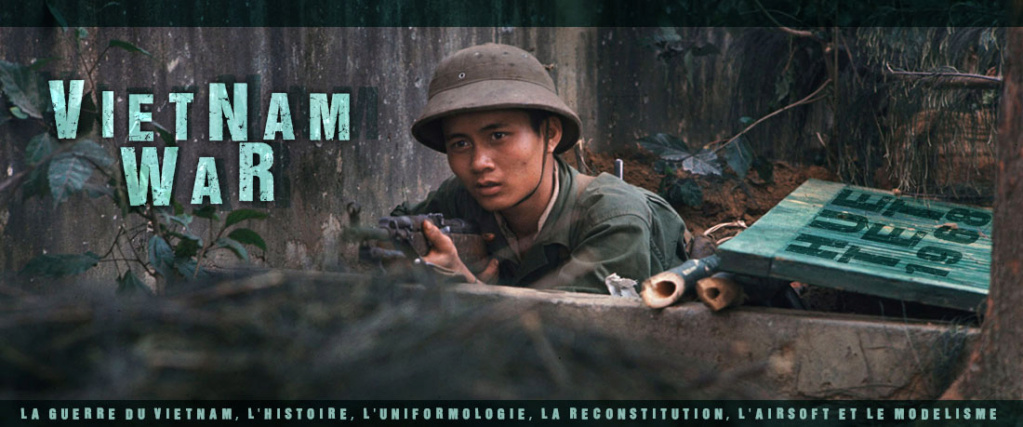
 Accueil
Accueil

